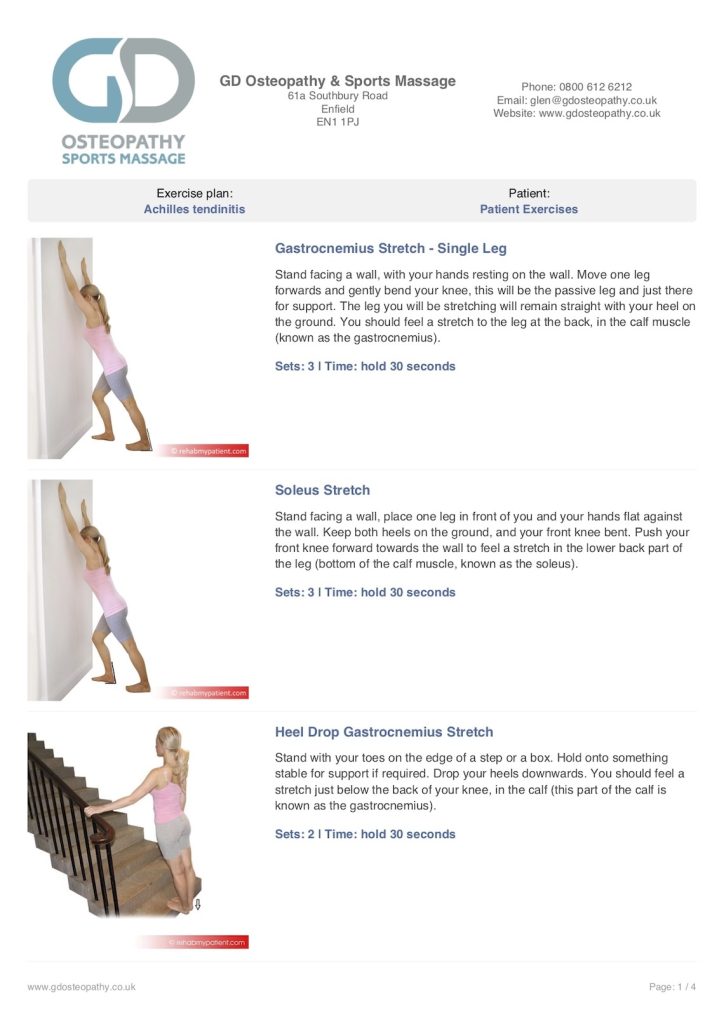Firstly a tendon is a tough band of tissue that connects a muscle to a bone. The Achilles tendon is one of the largest tendons in your body. It connects the muscles within your calf to your heel bone in your foot. The job of the Achilles tendon is to transfer the force generated by your calf muscles to your feet.
Propelling your body forward during running, walking and jumping. This tendon is particularly susceptible to injury. This is due to both, the huge forces generated by your calf muscles and the fact that the Achilles tendon has a relatively poor blood supply. A poor blood supply limits your body’s ability to repair effectively.
Achilles tendinitis or tendinosis
Achilles tendinitis is an inflammation of your Achilles tendon. The inflammation and swelling normally occurs just above the heel bone at the back of your ankle. This particular area is commonly injured as it has the poorest blood supply. Acute inflammation tends not to be there too long.
However the condition often progresses to chronic inflammation. Which can develop further into a degenerative state. If your tendon becomes degenerative it is referred to as Achilles tendinosis.
With Achilles tendinosis, the fibres that make up your tendon become disorganised and micro tears develop. The body continually attempts to repair the area, but the degeneration often occurs at a faster rate. Over time the tendon becomes thicker, harder and calcium deposits begin to form. If this process continues, it can result in a partial or full tendon rupture.
Symptoms
Common symptoms of Achilles tendinitis are:
- pain and stiffness along the Achilles tendon
- swelling and thickening of the tendon
- tenderness when touching the tendon
- pain and swelling gets worse with activity
- symptoms aggravated the day after exercise
- calcium deposits / nodules within the tenon

Causes
The most common cause of Achilles tendinitis is a sudden explosive action of the foot and ankle. But repetitive activities can also cause damage over time. The most common causes include:
- Sports: running (particularly up hill), jumping, football and tennis.
- Jobs: occupations that involve a lot of repetitive stress being placed on the ankles and feet i.e. postman.
- Age: as you age the blood supply to the Achilles tendon continues to decrease, this limits the bodies ability to heal.
- Leg length discrepancy: the alteration in mechanical load can lead to increased stress on the Achilles tendon.
- Overpronation: if the arch of your foot flattens too much, it can produce a torsional strain on the Achilles tendon.
- High heel shoes: continually wearing high heel shoes, shortens the muscles of the calf. This creates more tension on the Achilles tendon.
Treatment
The single most important part of treating your Achilles tendinitis is to rest. Your tendon and muscles need time to recover, so you must stop or alter the activity that caused your injury.
Activity modification
As previously mentioned, if you have been doing lots of hill running then stop. Give your tendon time to recover fully before gradually reintroducing hills. If your feet are overpronating, consider wearing arch supports to reduce the twisting effect on the Achilles tendon. Have you been wearing high-heeled shoes for a long time? If so gradually reduced the height of the heel week by week, until flat shoes become comfortable.

Rehabilitation
The focus of rehabilitation is to speed up your recovery. This is done by improving tissue repair, reduce pain, decrease inflammation and improving strength and flexibility.
Ice: apply ice to your Achilles tendon (not directly to the skin) 10 minutes, three times a day, this will relieve pain and inflammation.
Strengthening and stretching exercises: follow the advice and exercises provided in the FREE Achilles tendinitis rehabilitation plan. These exercises can be done as often as, every other day. Mild discomfort is okay, but if any movements cause you pain, then stop. These exercises will reduce muscle tension and improve your strength and flexibility. Please note that the strengthening exercises should only begin, once acute pain and inflammation has subsided.
Manual therapy: find a good therapist, such as our Enfield Physio or Enfield Osteopath. Your therapist should perform:
- therapeutic ultrasound to reduce inflammation and speed up healing.
- massage therapy to reduce muscle tension and improve blood flow.
- joint mobilisation to increase foot and ankle mobility,
- taping to help unload the tendon, reducing the stress on the area.

